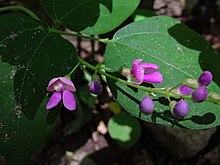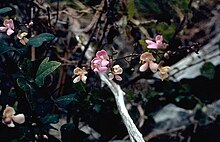| Phaseolus polystachios | |
|---|---|

| |
| Conservation status | |
 Least Concern (IUCN 3.1) | |
| Scientific classification | |
| Kingdom: | Plantae |
| Clade: | Tracheophytes |
| Clade: | Angiosperms |
| Clade: | Eudicots |
| Clade: | Rosids |
| Order: | Fabales |
| Family: | Fabaceae |
| Subfamily: | Faboideae |
| Genus: | Phaseolus |
| Species: | P. polystachios |
| Binomial name | |
| Phaseolus polystachios (L.) Britton, Sterns & Poggenb. | |
| Synonyms | |
| |

Phaseolus polystachios, also known as the thicket bean or wild kidney bean, is a perennial, herbaceous vine that is native to North America. It is unique among the Phaseolus in that its native range extends across the eastern temperate United States to southeast Canada, while most Phaseolus are tropical or subtropical. It is the namesake for the Polystachios group clade, which is the most species-rich within Phaseolus (17 species). In spite of its common name, it is more closely related to the lima bean (Phaseolus lunatus), and it holds potential as a crop wild relative due to its resistance to white mold (Sclerotinia sclerotiorum).
Subordinate taxa
Subordinate taxa include Phaseolus polystachios var. polystachios, Phaseolus polystachios var. sinuatus, and Phaseolus polystachios var. smilacifolius. The Phaseolus polystachios var. polystachios variety is listed as a special concern species and believed extirpated in Connecticut.
Ethnobotany and uses
Phaseolus polystachios has been found in a few Native American archaeological sites in Oklahoma and Arkansas, with some evidence of artificial selection for indehiscent (non-shattering) pods. Its fruit and seeds can reportedly be eaten in much the same way as cultivated Phaseolus, although they are smaller.
Life history
Phaseolus polystachios exhibits hypogeal germination and is photoperiod sensitive, requiring day lengths greater than 10 hours to vine and flower. It overwinters via a tuberous root system.
Ecology
Phaseolus polystachios inhabits well-drained soils and slopes, generally woodlands and thickets, and may form colonies. Their pods are eaten extensively by weevils.
References
- ^ Contu, S. (2012). "Phaseolus polystachios". IUCN Red List of Threatened Species. 2012: e.T19892040A20127299. doi:10.2305/IUCN.UK.2012.RLTS.T19892040A20127299.en. Retrieved 12 November 2021.
- ^ "Plants Profile for Phaseolus polystachios (Thicket bean)". plants.usda.gov. Retrieved 12 December 2017.
- Delgado-Salinas, Alfonso; Bibler, Ryan; Lavin, Matt (2006-10-01). "Phylogeny of the Genus Phaseolus (Leguminosae): A Recent Diversification in an Ancient Landscape". Systematic Botany. 31 (4): 779–791. doi:10.1600/036364406779695960. ISSN 0363-6445.
- ^ "The Quest for the Wild Kidney Bean - The Plant Press". nmnh.typepad.com. Retrieved 2018-06-23.
- "Tropicos | Name - Phaseolus polystachios subsp. smilacifolius (Pollard) Freytag". www.tropicos.org. Retrieved 2018-06-23.
- "Connecticut's Endangered, Threatened and Special Concern Species 2015". State of Connecticut Department of Energy and Environmental Protection Bureau of Natural Resources. Retrieved 2 January 2017. (Note: This list is newer than the one used by plants.usda.gov and is more up-to-date.)
- ^ "Phaseolus polystachios (L.) BSP. - Wild Bean | Paleoethnobotany Laboratory Guide". pages.wustl.edu. Retrieved 2018-06-23.
- ^ Allard, H.A. (1943). "The probable relationship of Phaseolus polystachios to other species". Rhodora. 45: 169–170.
- ^ Allard, H. A. (1947). "The ecology of the wild kidney bean Phaseolus polystachios (L.) BSP". Journal of the Washington Academy of Sciences. 37 (9): 306–309. JSTOR 24531921.
| Phaseolus species and cultivars | |
|---|---|
| Phaseolus vulgaris | |
| Other species | |
| Related | |
| Taxon identifiers | |
|---|---|
| Phaseolus polystachios |
|
| Dolichos polystachios | |
This Phaseoleae-related article is a stub. You can help Misplaced Pages by expanding it. |